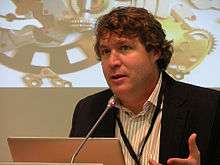George Siemens
George Siemens is a writer, theorist, speaker, and researcher on learning, networks, technology, analytics and visualization, openness, organizational effectiveness, and complexity in digital environments.[1] He is the originator of Connectivism theory and author of the article Connectivism: A Learning Theory for the Digital Age and the book Knowing Knowledge - an exploration of the impact of the changed context and characteristics of knowledge.[2][3] He is the founding President of the Society for Learning Analytics Research (SoLAR).[4] He is also a father of three: a boy and two girls.
George Siemens | |
|---|---|
 Siemens at UNESCO conference, 2009 | |
| Born | 1970 (age 49–50) |
| Citizenship | Canada |
| Alma mater | University of Aberdeen (PhD) |
| Scientific career | |
| Fields | Learning Analytics, massive open online courses, digital education |
| Institutions |
|
| Academic advisors | Martin Weller |
Academic activity
Siemens joined the faculty and staff of The University of Texas at Arlington[5] in December 2013 as the executive director of the Learning Innovation and Networked Knowledge Research Lab or LINK Lab, which opened in spring of 2014.[6] He was formerly a professor at the Center for Distance Education and a researcher and strategist with the Technology Enhanced Knowledge Research Institute (TEKRI) at Athabasca University in Alberta, Canada.[7][1] His role as a social media strategist involves planning, researching, and implementing social networked technologies, with a focus on systemic impact and institutional change.[8]
Prior to Athabasca University, Siemens held a post as the Associate Director, Research and Development with the Learning Technologies Centre at the University of Manitoba. His PhD work, with the University of Aberdeen, focused on how individuals sensemake and wayfind in complex information settings. Siemens has received honorary doctorates from the Universidad de San Martin de Porres[1] (May 2012) and the University of the Fraser Valley[9] (June 2014).
Massive Open Online Courses (MOOCs)
Siemens is a prominent Canadian educator in the massive online open course (MOOC) format. In 2008, Siemens and Stephen Downes designed and taught a MOOC which was reported as a "landmark in the small but growing push toward 'open teaching,'" and has since offered various additional MOOCs which have gained popular worldwide attention.[10]
Distinction between cMOOCs and xMOOCs
Siemens' traditional offerings, since they are created in the connectivist format, are referred to as cMOOCs, as distinguished from institutional MOOC offerings, called xMOOCs, which tend to be either instructivist or constructivist.[11] Siemens, together with Baker, Gasevic, and Rose,[12] as well as others like Mitros and Cormier,[13] have been working on bridging the two formats.
See also
Notes
- "George Siemens". Technology Enhanced Knowledge Research Institute. Retrieved 2018-05-11.
- Siemens, George (2004-12-12). "Connectivism: A Learning Theory for the Digital Age". elearnspace. Archived from the original on 2010-02-01. Retrieved 2018-05-11.
- Siemens, George (2006). Knowing Knowledge (PDF). ISBN 9781430302308. Archived from the original (PDF) on 2008-07-04. Retrieved 2009-08-28.
- "About SoLAR". Society for Learning Analytics Research (SoLAR). 2014-02-14. Retrieved 2018-05-11.
- http://www.uta.edu
- "Digital learning innovator to lead new research at UT Arlington". University of Texas at Arlington. 2014-01-09. Archived from the original on 2018-01-20. Retrieved 2018-05-11.
- "Faculty". Centre for Distance Education, Athabasca University. Retrieved 2018-05-11.
- "About George Siemens". elearnspace. Archived from the original on 2018-04-14. Retrieved 2018-05-11.
- Russell, Anne (2014-06-02). "UFV to confer honorary degrees on Doug Hamilton, Charllotte Kwon, and George Siemens | UFV Today". University of the Fraser Valley. Retrieved 2018-05-11.
- Parry, Marc (August 29, 2010). "Online, Bigger Classes May Be Better Classes". Chronicle of Higher Education. Retrieved 2010-09-02.
- Heick, Terry (2017-06-17). "The Difference Between Instructivism, Constructivism, And Connectivism". TeachThought. Retrieved 2018-05-11.
- Collaço, Elen (2014-10-29). "My reflections on dual-layer MOOC (DALMOOC)". elencollacoblog. Retrieved 2018-05-11.
- Cormier, Mitros, Pritchard. "Teaching Physics at Scale." PERC2014.
External links
| Wikimedia Commons has media related to George Siemens. |
- George Siemens' blog 'elearnspace.org'
- George Siemens' webpage Connectivism.ca
- Twitter: @gsiemens